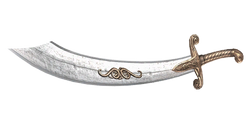| This article is about the Persian scimitars of Renaissance Italy. You may be looking for the Persian Scimitars of Edward Kenway. |

The Persian Shamshir
The Persian Shamshir, also known simply as the Scimitar, is a broad saber of Persian origin which had made its way to Italy by the time of the Renaissance. Commonly employed by the guards of the Italian city-states, it was also sold closer to its roots in Constantinople during the rule of the Ottoman Empire.
Description[]
As a scimitar, the Persian Shamshir consists of a single-edged blade with a rather radical curvature. It is distinctive for the prominent broadness of this clip-point blade, along with the exquisite, metallic markings at the center of both sides. The hilt, forged from a golden metal, is similarly elegantly decorated.[1][2][3]
The scimitars, as sold in Italy during the Renaissance, were deadlier and more resilient against clashes with enemy swords than their counterparts in the Ottoman Empire. However, the ones sold in Constantinople, while lacking in keenness, were nevertheless lighter, allowing its wielder to strike more swiftly.[1][3]
History[]
Despite their foreign design, Persian Shamshirs were an uncommon weapon among the soldiers of the Italian city-states during the 15th century. Indeed, guards, whether Florentine or Venetian, Medici or Borgia were known to equip them, and they were sold by blacksmiths in Florence, Venice, Forlì, San Gimignano, and Monteriggioni from around 1480 onward. Between that year and 1499, the Assassin Ezio Auditore da Firenze purchased one of these scimitars and mounted it on one of the racks in his weapon room.[1]
When he relocated his operations to Rome in 1500, the Persian Shamshir was one of the weapons he did not acquire for his new base on Tiber Island as the Roman blacksmith shops did not supply them. In spite of this, the Borgia guards of Rome still regularly utilized the scimitars.[2] The scimitars were still being manufactured and sold in Constantinople a decade later, and as before, Ezio bought one of them for the Assassin headquarters in that city during his time there.[3]
Weapon statistics[]
| Era | Damage | Speed | Deflect | Cost | Availability |
| Italian Renaissance (15th c.) | 3 | 3 | 5 | 11,300ƒ | Sequence 6 |
| Italian Renaissance (16th c.) | 3 | 3 | 5 | N/A | Sequence 3 |
| Ottoman Empire (16th c.) | 1 | 4 | 3 | 3,163 |
Sequence 2 |
Trivia[]
- In Persian, shamshīr (شمشیر) is the general word for "sword" and can refer to any sword regardless of type or origin.
- In Assassin's Creed II, the weapon is known only as the Scimitar. In Revelations, it is called the Persian Shamshir.
- Although available for purchase at blacksmith shops in Assassin's Creed II and Revelations, the scimitars are not found in the shops of Brotherhood, where they can only be equipped by looting or disarming a guard wielding one.
- The Persian Shamshir should not be confused with the similarly Persian Scimitars of Black Flag. Though of different design, technically the names for either are interchangeable since the Persian word shamshir has been loaned into English as a general word for a scimitar of Persian design.
Appearances[]
- Assassin's Creed II (first appearance; as the "Scimitar")
- Assassin's Creed: Brotherhood
- Assassin's Creed: Revelations (as the "Persian Shamshir")
